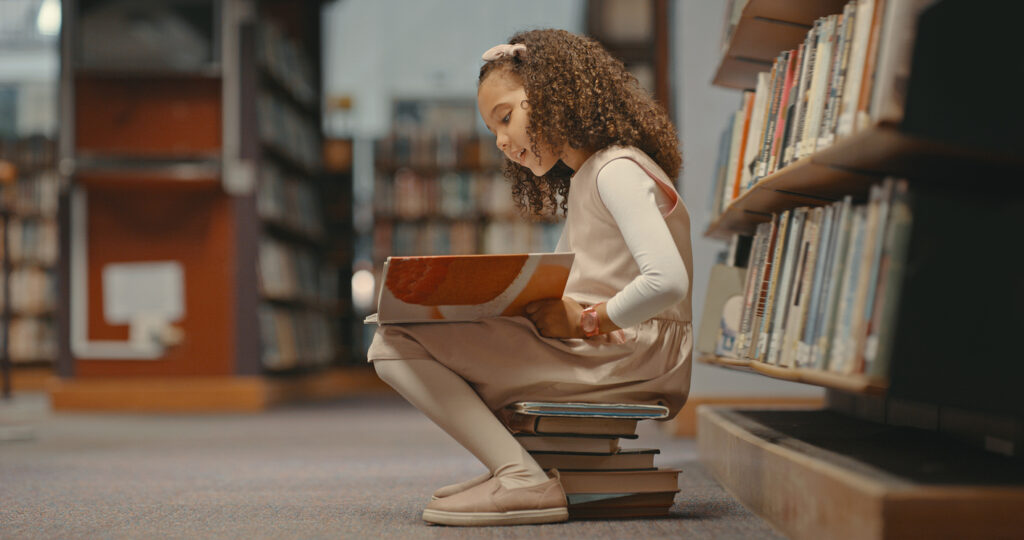This post was written by NCTE member Lorraine Radice, reprinted with permission from Edutopia.
Women’s History Month provides an opportunity for students to study inspiring people who have created opportunities for themselves and others through their legacies. It’s also a space where students can discover their identities through learning about the achievements of others.
Through picture book readalouds about women who represent a myriad of interests and achievements, students can make personal connections to content that’s familiar or develop a new interest in or perspective on a particular area.
I curated the picture book list below to represent accomplished women within a variety of fields. A common denominator among all figures is that they exemplify perseverance, determination, creativity, and strength.
I’ve also included discussion questions to get the conversations started. Consider planning opportunities to have students turn and talk during the read aloud. You may also want to use the books as catalysts for independent or group research projects.
AREA OF INTEREST: MUSIC
Dancing Hands: How Teresa Carreño Played the Piano for President Lincoln, by Margarita Engle, illustrated by Rafael López.
Playing the piano was the way Teresa Carreño shared joy. Forced to leave their home in Venezuela, she and her family arrived in the United States during the Civil War, where Teresa became famous as the Piano Girl. (Preschool–grade 3)
For discussion:
- What is a talent you have that can bring joy to yourself and others?
- Share about a time when you had to overcome a challenge, and turning to your talent helped you.
AREA OF INTEREST: ART AND DESIGN
Dressing Up the Stars: The Story of Movie Costume Designer Edith Head, by Jeanne Walker Harvey, illustrated by Diana Toledano.
Edith Head grew up in a small town but always had big dreams of becoming a costume designer in Hollywood. She was the first woman to head a major Hollywood studio costume department and received several Academy Awards. (Preschool–grade 3)
For discussion:
- Share about something you want to learn to do but have no experience with yet. What steps do you need to take to learn?
- What personal qualities help someone to achieve their dream?
AREA OF INTEREST: ACTIVISM
More Than Peach, by Bellen Woodard, illustrated by Fanny Liem.
When Bellen Woodard noticed that her classmates referred to one crayon as the “skin color” crayon, she realized that the many skin colors people have should be included among the crayons, and she worked to get the crayon industry to create those crayons. (Kindergarten–grade 2)
Words of Wonder from Z to A, by Zaila Avant-garde, illustrated by Keisha Morris.
Zaila Avant-garde was the first Black American student to win the Scripps National Spelling Bee in 2021. Zaila excels in spelling, writing, basketball, and science—serving as a role model for young people, inspiring them to work toward their dreams. Zaila also wrote (with Marti Dumas) It’s Not Bragging If It’s True: How to Be Awesome at Life. (Preschool–grade 2)
Malala’s Magic Pencil, by Malala Yousafzai, illustrated by Kerascoët.
Malala wished for a magic pencil when she was young to make people happy and erase unpleasant things. The magic pencil is a theme that highlights Malala’s wishes to end violence, to make the world a better place, and to amplify the power of a single voice. The author introduces readers to some aspects of her life in Pakistan, including people trying to silence her voice. But she never gave up on working hard to peacefully achieve her dreams. (Preschool–grade 3)
For discussion:
- Describe a time when you acted as a leader for an important cause.
- Share about something you may notice within your community that prevents all people from feeling included. What can you do so that all are represented and belong?
AREA OF INTEREST: GAMES AND PLAY
The Queen of Chess: How Judit Polgár Changed the Game, by Laurie Wallmark, illustrated by Stevie Lewis.
Judit Polgár had a love for competition. She pursued her passion for playing chess and became a fierce competitor among peers and adults. She is the youngest chess grandmaster in history. (Kindergarten–grade 4)
For discussion:
- What is something you have a passion for that you practice often?
- Why is it important to put time into learning and practicing something you want to be successful in?
AREA OF INTEREST: SCIENCE
Queen of Physics: How Wu Chien Shiung Helped Unlock the Secrets of the Atom, by Teresa Robeson, illustrated by Rebecca Huang.
Wu Chien Shiung overcame racism and sexism when she emerged as the “Queen of Physics” for her work on beta decay. She was the first woman to earn many achievements, including being elected president of the American Physical Society. (Kindergarten–grade 2)
The Girl Who Thought in Pictures: The Story of Dr. Temple Grandin, by Julia Finley Mosca, illustrated by Daniel Rieley.
Follow the timeline of Temple Grandin’s life in this book that captures how and why she emerged as a leader in science. Temple’s unique mind and ability to process information visually led her to design improvements for farms and animals around the world. (Grades 2–5)
The Leaf Detective: How Margaret Lowman Uncovered Secrets in the Rainforest, by Heather Lang, illustrated by Jana Christy.
Margaret Lowman studied the natural world of the rainforests. She faced discrimination from male teachers who refused to let her into their classrooms. She also met challenges in completing her research because of people cutting down trees and clearing the rainforests, but she never gave up on her dream. (Grades 2–5)
For discussion:
- Why is it important to honor all types of thinkers when you’re part of a team or community?
- What areas of the natural world interest you, and how can you contribute to preserving parts of our environment?
AREA OF INTEREST: MATHEMATICS
The Girl With a Mind for Math: The Story of Raye Montague, by Julia Finley Mosca, illustrated by Daniel Rieley.
Raye Montague was a gifted mathematician and dreamed of being an engineer. She is known for her influence on how ships are designed. (Grades 2–5)
For discussion:
- What are some areas in which you could apply your love for math to make a difference?
- How might you overcome the challenge of people doubting your abilities?
AREA OF INTEREST: GOVERNMENT
Turning Pages: My Life Story, by Sonia Sotomayor, illustrated by Lulu Delacre.
Sonia Sotomayor is the first Latina Supreme Court Justice. In this autobiography, she shares how books helped her through difficult circumstances in her life and led her to discover strength within herself. (Preschool–grade 3)
For discussion:
- Share about how books can be a mirror and/or window for readers.
- What book is a mirror for you? What book is a window for you? What does reading that book help you to reflect on or discover?
Picture books offer a wealth of information in ways that are accessible and engaging for students of all ages. Readers develop new understandings of content and can use the picture book exploration as a pathway to additional reading and learning.

Lorraine Radice, Ph.D. is a PreK-12 Director of Literacy in a public school district in New York and an Associate Assistant Professor at Hofstra University. Dr. Radice is the author of the book Leading a Culture of Reading: How to Ignite & Sustain a Love of Literacy in Your School Community and is a contributing author to the research volume Curriculum, Instruction, and Assessment: Intersecting New Needs and New Approaches. She has also published with Edutopia, Literacy Today by International Literacy Association, NCTE Blog, and ASCD. Dr. Radice presents at several national and local conferences and facilitates professional development in schools. Connect with her on X and Instagram at @LorraineMRadice and on Facebook.
It is the policy of NCTE in all publications, including the Literacy & NCTE blog, to provide a forum for the open discussion of ideas concerning the content and the teaching of English and the language arts. Publicity accorded to any particular point of view does not imply endorsement by the Executive Committee, the Board of Directors, the staff, or the membership at large, except in announcements of policy, where such endorsement is clearly specified.
You can find more lists featuring nonfiction books on our Orbis Pictus Award® winning books list or the Mathical Book Prize Winners list.

